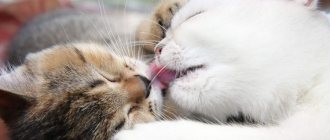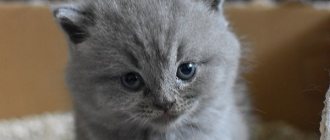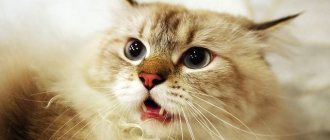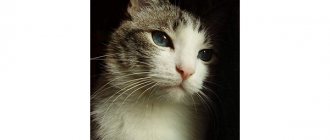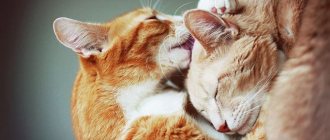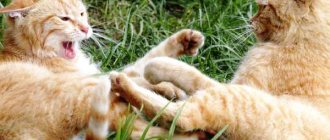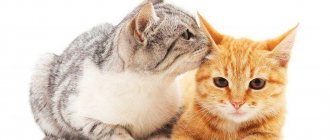In the process of domestication, the cat lost some habits and skills of a wild animal and acquired new ones, characteristic only of domestic animals. One of these newly acquired habits is licking “your” person. Scientists note that cats that are constantly in an apartment have much more active contact with humans than those pets that go outside and can communicate with outbred brothers, go about their cat business and gain new experiences. Let's look at the TOP 7 reasons why a cat licks a person.
Reasons for the unusual cat habit
Any animal is attached to its owner. It is generally accepted that cats are loners by nature, loving to “stand their ground.” But not everyone should be considered that way. Cats, like people, have different personalities. Some animals absolutely cannot do without their owner and start licking him for an hour.
The main reasons why a cat licks a person are:
- thermoregulation;
- reaction to odors;
- expression of love;
- maternal instincts;
- dominant or passive behavior;
- lack of attention;
- diseases.
Everyone knows that a cat’s body temperature is much higher than a human’s. It is almost 39 degrees. Due to this, cats are extremely thermophilic and require large amounts of heat to warm their bodies. The human body emits a huge amount of heat, which is very attractive to your pet.
Many owners notice that cats prefer to lie down and start licking exactly the place where pain occurs in humans. This is explained by the fact that the diseased organ produces increased heat, which in turn is greatly preferred by representatives of the cat family.
Cats have always been attracted to different smells. For example, they love the smell coming from human hair. Especially after washing your hair. The cat perceives hair as “fur” on humans, so it licks it.
To avoid additional “washing” of your hair, it is recommended to use citrus-scented shampoos. You can also distract your pet from licking with food or toys.
The reason why a cat licks its owner can also be explained as follows . While being in close proximity to a person, the pet experiences such a pleasant feeling of comfort and calm.
If a pet shows an active interest in the child in the house, then it is likely that she perceives the human child as her own. The mother cat is always nearby and constantly licks her babies. For this reason, a “dose” of washing and sleeping in an embrace with a “furry mommy” in such a situation are provided to the child without fail.
In order to avoid some discomfort during sleep, the cat owner is not recommended to accustom her pet to sleep with people. It is important to note that if the animal has not undergone the procedure of castration or sterilization, but has not produced offspring, cats exhibit false maternal instincts. Cats may experience hormonal imbalances. Therefore, it is important for owners who do not plan to breed offspring to resolve this issue in a timely manner.
Persistent licking of the owner's hands or face can be a kind of signal for help for various diseases in the animal . For example, it may be bothered by parasites in its fur, so it becomes restless and licks not only itself, but also people. If you suspect any disease, it is better not to start self-medication, but to consult a specialist.
Licking a person due to lack of attention
Cats deprived of attention will strive to take out their anger on objects in the apartment, and repeated refusals can lead to a complete loss of trust, which will be very difficult to restore. Some aggressive cats may even bite their owner.
A sign of an invitation to groom a cat is:
- ears pressed to the back;
- nose pokes in the hand;
- and licking of hands and face.
Sometimes this causes the pet to lie flat on the floor or other surfaces. In addition, the cat can lick the face, demonstrating its affection for the owner. Usually the animal itself turns to the owner with a certain part of its body, showing exactly where it should be scratched.
The most pleasant areas for scratching in cats are the forehead and ears. It is more correct to scratch the forehead against the grain, and the ears at the base, gently pulling. Some animals allow their owner to scratch their belly, and many enjoy scratching during shedding. You should not make small intermittent movements, as the pet will receive greater pleasure from continuous combing - from head to tail.
Many animals begin to emit a gentle purr when scratched. Such sounds are confirmation that the pet is experiencing pleasure, and grooming should continue.
As a sign of affection, cats lick the owner's face and hands. You can start scratching your cat without calling him. You should extend your hand in his direction and scratch 10 centimeters from him. If your pet, with its ears flattened, approaches your hand and licks it, this is a good sign. It means the call for grooming has been accepted.
Dominant and passive behavior
Domestic cats are capricious animals; their wild ancestors lived in their natural habitat. Dominant behavior of a cat is shown by grooming (licking). Sometimes an animal licks another individual, this is how cats demonstrate their high position in the pack. Also, dominant cats can signal others to lick themselves, and in this case this is interpreted as a command. Therefore, when a pet uses signs to invite its owner for grooming, you should not ignore the pet’s demands.
Passive behavior, on the contrary, is characteristic of those animals that, for some reason, experience stress and anxiety. In this case, this behavior, when the cat licks the owner, occurs due to forced submission. Often, after such a seemingly calm licking of hands, unexpected bites from the pet may follow.
In general, licking the owner's hands or face is normal. An alarming factor may be the case when such loving behavior from a pet has not previously been observed. If all this is additionally accompanied by changes in behavior - refusal to eat or active games, you should consult a specialist.
Despite the fact that cats cannot be called gourmets due to the lack of a sufficient number of taste buds, they still have special food preferences. And, perhaps, the most interesting and unusual product from the entire cat diet can be called human earwax.
It would seem, what is missing from a well-fed cat, eating special food, that she licks her ear with such care and smacking? As it turned out, in this case the animal’s natural instincts awaken. The fact is that cats are not attracted to the taste of sulfur, but to its smell.
Earwax is a mixture of fatty secretions and dead cells that have a special unique aroma and are associated by the cat with the aromas of the natural environment. For example, dead cells are protein, and protein is a nutritional substance for any animal. If this smell is enhanced by ether, which is contained in the fatty residue, then the cat simply will not be able to resist the opportunity to get enough of the beneficial substances .
Structure and physiology of the ears
A cat's ears are a very important organ. With their help, the animal is perfectly oriented in space and hears what is happening in the surrounding world. The ear performs the function of the vestibular apparatus, maintaining the cat's balance. Therefore, it is very important to ensure that dirt does not accumulate in it and to clean it in a timely manner.
© shutterstock
In cats, a lot of wax can accumulate in the ears due to their complex structure. The ear consists of 3 sections :
Read also: Why you can’t do laundry on Sunday?
- Outer ear . The auricle passes into the external auditory canal. The latter has a tortuous structure, and its surface secretes a softening secretion.
- Middle ear . Represented by the eardrum and the connection of several bones. On them, the membrane transmits sounds through vibrations.
- Inner ear . It contains a large number of tubes containing liquid - a labyrinth. The tubes are filled with liquid, which moves through them evenly. Thanks to this, the cat does not lose its balance.
Discharge from cats' ears should not cause concern to the owner, because it serves a protective function. If the released sulfur is odorless, light with a yellowish tint, this is normal and does not require treatment. A moderate amount of sulfur protects the inner surface of the ears from drying out, and prevents dangerous microorganisms, dust, and dirt from penetrating into the depths of the shell.
Owners often notice that their cat loves earwax. The animal likes the smell of the discharge. This is due to the varied chemical composition of sulfur. After all, it contains alcohol, mineral acids, cholesterol, and a special ester. The latter has a beneficial effect on the condition of the animal’s coat, making it smooth and shiny.
© shutterstock
Read also: why you want pickled cucumbers
A way to communicate with “friends”
One of the main ways animals communicate is through chemicals called pheromones. Smell plays a big role in a cat's life. There are a huge number of glands on the cat's body that produce odorous substances. They are concentrated on the temples, in the corners of the mouth, on the chin, at the base of the tail and along it. The glands on the head secrete substances that carry more individual information, while the glands in the tail secrete group information.
By licking its owner and then applying new marks, the kitty leaves messages for us and its relatives.
Expression of love and affection
There are so-called “pacifying” pheromones. Their number increases after the birth of kittens and begins to decrease after the cat stops feeding the babies.
It is by the presence of such pheromones that zoopsychologists explain the attachment that a person feels for a cat. By thoroughly licking its owner and then rubbing its muzzle against him, the cat removes “foreign” odors and introduces its own. This is what happens when a furry family member wants to mark their human.
Licking is akin to hugs and kisses, a special sign of love. By exchanging smells with a person, cats “include” him in their group or “pack” on equal terms.
Treatment
The veterinarian prescribes treatment not that concerns the itching, but that concerns the very cause of the disease. The course of treatment consists of taking medications and includes both local and internal medications. Depending on the cause of the disease, the veterinarian may prescribe antibiotics, antihistamines (to eliminate allergies), and antifungals.
If scabies and redness of the skin are caused by an allergy to food or hygiene products, their use will have to be stopped and the food replaced with another, in general, to get rid of all allergens.
“I’m in charge”
A cat, by licking its relatives and humans, can show its position in the pack. Since a person cannot distinguish all the shades of odors applied to him, one should try to read the “body language”.
When a cat is relaxed, happily licks the hair or face of the owner, gently rubs her face or head against him, then in this way she marks her ward, showing other cats that she is the boss in the house, and the person is under her care. This is how a mother cat licks her kittens.
What to do if your cat is constantly licking
Having noticed that the cat has begun to lick and scratch almost all the time, and this is no longer simple self-care, the owner first of all needs to examine his pet for fleas. If fleas are not found, you need to remember whether one cat food was changed to another, whether a new shampoo was used, and whether any plant bloomed in the house.
A cat that scratches itself until it bleeds, licks itself and shakes its head frequently is most likely suffering from one of the skin diseases. You need to take her to the vet immediately. It will not be possible to make a diagnosis on your own, since scratching can be accompanied by many pathologies.
At the veterinary clinic, scrapings will be taken from the cat and microscopic and bacteriological studies will be carried out on their basis. They will allow you to identify fungal spores (if microsporia and trichophytosis occur) or mites (if demodicosis, sarcoptic mange or notoedrosis are present).
If the veterinarian suspects hormonal disorders, he may refer you for a blood test and, based on the results, will conduct an examination of the cat’s endocrine system.
Lack of impressions
Animal psychologists have noticed that “indoor” cats are more prone to licking people. Obviously, they do this due to a lack of impressions. Those animals that can go outside realize their instincts, thirst for knowledge and entertainment outside the home. They leave marks on houses and trees, chase birds and sort things out with yard cats. When they come home, they want to eat and sleep.
Those animals whose world is limited by four walls seek impressions in this limited space, turning their attention to the “group member” - the person. When he comes from the street, he brings a lot of interesting and unusual things, including new smells.
While licking its owner, the domestic cat seems to be reading a fascinating newspaper with news.
But cats walking on the street have another peculiarity - when they come back from a walk, they strive to rub against the owner’s legs. Scientists believe that in this way they apply a homely scent to their fur so that other pets do not perceive it as a stranger.
What you need to clean your ears
To carry out hygiene procedures you need:
- Cotton swabs, disks, clean napkins (not wet)
- Special lotions and gels that can be purchased at a pet store. Remember that there are preventative ear cleaning products, as well as medications that are prescribed only by doctors.
- Hygienic powder for cats, which can be used for heavy discharge, as well as for ear disease of the pet. There is no need to use powder for preventive measures.
Stress management
The cat carefully licks itself not only to clean and comb its fur. The animal's tongue has hard papillae that massage the skin and stimulate the production of endorphins - the hormones of happiness. In addition, on the surface of the animal’s fur there is a substance similar to B vitamins, which normalize mental balance and calm. If a cat is not allowed to lick itself, it will get sick and die.
In the same way, a pet takes care of its owner. The cat is very sensitive to the emotional state of a person. Scientists believe that during stress, biochemical processes in the body change, and substances released to the surface of the skin also change. A cat can “smell” when its owner is sad, afraid or angry. The only available way to calm him down is licking, massage, sound vibrations - rumbling.
The cat not only treats some diseases, as bioenergetics claims, but also monitors the mental balance of its owner, curing stress, depression, and bad mood.
Diseases accompanied by the appearance of brown plaque in a cat’s ears
The most common diseases accompanied by the appearance of brown plaque in the ears of a pet are otodectosis and otitis media. Both pathologies are deadly, but with timely detection and referral to a specialist, they can be treated quite successfully.
Otodectosis
Otodectosis or ear scabies is a parasitic disease caused by microscopic sarcoptoid mites otodectos cynotis. It is impossible to see the parasite with the naked eye; the arthropod measures 0.2-0.5 mm. Carnivorous arachnids parasitize the external auditory canal, eardrum and auricle, feeding on epidermal scales, blood and lymph. To lay eggs, female mites make multiple punctures in the skin and penetrate into the subcutaneous layers.
Taking care of hygiene
Well, of course, when licking a person, a cat tries to clean his “skin”, just as she is used to caring for her kittens. In the wild, a strong smell can give away an animal and attract an enemy. To destroy it, the cat will carefully lick hands washed with scented soap or neck or hair scented with shampoo.
Cleansing a person from sharp, unpleasant or alien aromas, the cat exchanges its pheromones with the owner, so that the person, even at a distance, feels an emotional connection with his pet and does not forget about him.
Manipulation
A cat, like any domestic creature, can manipulate its owner using various signals. By licking a person, the fluffy dog demands attention or treats from him. When a cat wants to play, she begins to lick her hands, ears, even clothes.
Begging for a tasty morsel can begin with carefully sniffing your fingers, cheeks, and lips. If you like the smell and the animal finds it appetizing, then it starts licking these places - you need to taste what smells so tempting.
You can name several more reasons why a cat enthusiastically licks a person, but it is impossible to decipher the intentions and signals of this mysterious animal with 100% certainty. Signals differ in meaning among domestic, yard and wild animals. Animal psychologists are just beginning to decipher the “language” of an animal that has been walking hand in hand with humans for thousands of years.
A thumbs up and subscription
are the best thanks to the author.
Share your opinion in the comments, we always read them.
Group on VKontakte | Read about cats in Zen
Original article:
https://porodakoshki.ru/pochemu-koshka-lizhet-cheloveka/
Cats are very smart, graceful and beautiful animals. But, on top of everything else, they are also the most mysterious. Many habits of cats are not understandable to humans. Such behavior also includes the habit of cats to lick their owner, and sometimes even lie down to sleep on him. It will be useful for any owner of a tailed pet to know why a cat licks its owner.
Reasons for the unusual cat habit
Any animal is attached to its owner. It is generally accepted that cats are loners by nature, loving to “stand their ground.” But not everyone should be considered that way. Cats, like people, have different personalities. Some animals absolutely cannot do without their owner and start licking him for an hour.
The main reasons why a cat licks a person are:
- thermoregulation;
- reaction to odors;
- expression of love;
- maternal instincts;
- dominant or passive behavior;
- lack of attention;
- diseases.
Everyone knows that a cat’s body temperature is much higher than a human’s. It is almost 39 degrees. Due to this, cats are extremely thermophilic and require large amounts of heat to warm their bodies. The human body emits a huge amount of heat, which is very attractive to your pet.
Many owners notice that cats prefer to lie down and start licking exactly the place where pain occurs in humans. This is explained by the fact that the diseased organ produces increased heat, which in turn is greatly preferred by representatives of the cat family.
Cats have always been attracted to different smells. For example, they love the smell coming from human hair. Especially after washing your hair. The cat perceives hair as “fur” on humans, so it licks it.
To avoid additional “washing” of your hair, it is recommended to use citrus-scented shampoos. You can also distract your pet from licking with food or toys.
The reason why a cat licks its owner can also be explained as follows . While being in close proximity to a person, the pet experiences such a pleasant feeling of comfort and calm.
If a pet shows an active interest in the child in the house, then it is likely that she perceives the human child as her own. The mother cat is always nearby and constantly licks her babies. For this reason, a “dose” of washing and sleeping in an embrace with a “furry mommy” in such a situation are provided to the child without fail.
In order to avoid some discomfort during sleep, the cat owner is not recommended to accustom her pet to sleep with people. It is important to note that if the animal has not undergone the procedure of castration or sterilization, but has not produced offspring, cats exhibit false maternal instincts. Cats may experience hormonal imbalances. Therefore, it is important for owners who do not plan to breed offspring to resolve this issue in a timely manner.
Persistent licking of the owner's hands or face can be a kind of signal for help for various diseases in the animal . For example, it may be bothered by parasites in its fur, so it becomes restless and licks not only itself, but also people. If you suspect any disease, it is better not to start self-medication, but to consult a specialist.
Licking a person due to lack of attention
Cats deprived of attention will strive to take out their anger on objects in the apartment, and repeated refusals can lead to a complete loss of trust, which will be very difficult to restore. Some aggressive cats may even bite their owner.
A sign of an invitation to groom a cat is:
- ears pressed to the back;
- nose pokes in the hand;
- and licking of hands and face.
Sometimes this causes the pet to lie flat on the floor or other surfaces. In addition, the cat can lick the face, demonstrating its affection for the owner. Usually the animal itself turns to the owner with a certain part of its body, showing exactly where it should be scratched.
The most pleasant areas for scratching in cats are the forehead and ears. It is more correct to scratch the forehead against the grain, and the ears at the base, gently pulling. Some animals allow their owner to scratch their belly, and many enjoy scratching during shedding. You should not make small intermittent movements, as the pet will receive greater pleasure from continuous combing - from head to tail.
Many animals begin to emit a gentle purr when scratched. Such sounds are confirmation that the pet is experiencing pleasure, and grooming should continue.
As a sign of affection, cats lick the owner's face and hands. You can start scratching your cat without calling him. You should extend your hand in his direction and scratch 10 centimeters from him. If your pet, with its ears flattened, approaches your hand and licks it, this is a good sign. It means the call for grooming has been accepted.
Dominant and passive behavior
Domestic cats are capricious animals; their wild ancestors lived in their natural habitat. Dominant behavior of a cat is shown by grooming (licking). Sometimes an animal licks another individual, this is how cats demonstrate their high position in the pack. Also, dominant cats can signal others to lick themselves, and in this case this is interpreted as a command. Therefore, when a pet uses signs to invite its owner for grooming, you should not ignore the pet’s demands.
Passive behavior, on the contrary, is characteristic of those animals that, for some reason, experience stress and anxiety. In this case, this behavior, when the cat licks the owner, occurs due to forced submission. Often, after such a seemingly calm licking of hands, unexpected bites from the pet may follow.
In general, licking the owner's hands or face is normal. An alarming factor may be the case when such loving behavior from a pet has not previously been observed. If all this is additionally accompanied by changes in behavior - refusal to eat or active games, you should consult a specialist.
There may be several reasons for this behavior. Most often, this is how she shows her love for her owner. Females lick their kittens, thereby ridding them of foreign odors and taking care of them. Therefore, when a cat licks a person, it thus shows its affection for him and “helps” get rid of what it considers foreign odors. After all, for them this is a very important and intimate moment in hygiene. According to another theory, by licking the owner’s fingers, she tries to attract attention to herself and begs for the next portion of delicacy.
Proper ear cleaning technique
If your cat categorically does not want to undergo the ear cleaning procedure, and tries in every possible way to escape from your hands, then it is better to secure the animal with a towel in advance.
Next you need to slightly turn the ear out. Moisten a cotton pad with a special cleanser, then wipe the inner part of the ear that is accessible to visual inspection with the cotton pad. Then, using a clean cotton pad or napkin, you need to remove any remaining wax and cleanser residue from the surface of the ear. In this case, all movements should be directed outward, but not inward, since there is a risk of damaging the deeper parts of the ear and causing infection there. Remains of lotion or gel can be removed from deep sections using hygienic cotton swabs.
What not to do when cleaning cats' ears?
The fundamental point during the entire procedure is that only the visible part of the auricle can be cleaned. Attempting to penetrate deeper will only harm the animal.
It is undesirable to use various folk remedies or self-made solutions. Their use will harm the cat: it is possible to dry out the epidermis of the inner surface of the ear and develop allergic reactions.
Do not clean your pet’s ears at home, on your own, if upon examination you find purulent discharge, crusts, bumps, or dark spots. In this case, you need to contact a specialist, because most likely the cat has a specific ear disease. In this case, professional help from a veterinarian is required.
Some owners, when carrying out a hygienic procedure, strive to achieve absolute, impeccable cleanliness of their ears. But this is also not entirely correct. Earwax, as mentioned above, has protective properties; a moderate amount of it is simply necessary.
You should not use self-made products instead of hygienic cotton swabs. This is dangerous, because their use can lead to traumatic damage to the ear and infection.
If you regularly carry out preventive ear cleanings for your pet, but this does not lead to the desired result, wax and dirt constantly accumulate, or suddenly you find purulent discharge on a napkin or cotton pad, you need to urgently contact a specialist.
So, the procedure for cleaning cats’ ears, it turns out, is not as simple a manipulation as it might seem at first glance. You still need to be aware of certain features and rules. But now, after reading this article, you know the general rules and subtleties of caring for cats’ ears. By following these simple instructions, you can properly care for your pet's ears.
Main reasons
Cats are one of the most independent and self-sufficient pets you can keep at home. Some people periodically feel like they are the ones living with their animal, and not the other way around, they behave so proudly. Therefore, when pets start licking their hands, many people want to think that this is only because of strong love and affection. However, this is not entirely true; there are also other reasons for this.
Expressing affection and care
This behavior is one of the main reasons for licking the head, hands, face, and hair of its owner. A cat avoids people who, for one reason or another, are unpleasant to them. This could be a smell, a neglectful or rude attitude towards an animal, and many others. Therefore, if a pet shows sympathy in this way, there is no need to scold or drive him away. This behavior will cause the animal to lose trust. When it becomes uncomfortable from prolonged licking with a rough and wet tongue, you should not drive the cat away, but divert his attention to a treat or toy.
Cat licks after sterilization
Cats always take special care to lick any slightest damage to the skin, be it a sore, wound or suppuration. And sterilization is a full-fledged operation, so the pet will definitely try to lick this wound, even through a blanket. As the postoperative scar heals, it begins to itch very much, and you want to scratch it furiously. All this can be disastrous for the cat and lead to serious complications. Therefore, it is recommended that the cat be given a surgical collar for ten days after surgery.
Symptoms of diseases
There are cases when licking people is a desire to draw attention to the pet’s health problems, and not a show of love or a request for affection. These may be diseases or conditions such as:
- Skin parasites, including fleas. The cat worries not only about itself, but also about the people around it, and is trying to get rid of the problem.
- Allergy. If feeding is incorrect or the food is changed, skin problems can occur, which leads to excessive licking of yourself and those around you.
- Disturbances in general health. By licking frequently, the animal tries to signal that something is wrong with it. It is important to notice changes in behavior and contact a veterinarian promptly.
- Infectious diseases. Some of them cause itching and rashes on the skin, which irritates the pet and he tries to get rid of it in this way.
Causes and diseases of cats that cause black plaque to appear
The dirt that owners find in their cat's ears is not always brown. Often its color is closer to black. The presence of a substance of this color in the ear means that the cat is most likely sick.
What exactly depends on the symptoms, but there are three main problems that almost every pet owner can face.
Otodectosis
This disease is caused by one of the most common parasites of cats - ear mites. Ear mites are arthropods that inhabit almost all ear canals and multiply rapidly.
It first settles in the outer ear. Having completely colonized it, the mite begins to colonize the medial and internal canals.
It is quite simple to determine that your cat has otodectosis - the brown plaque continues to accumulate even after its removal, which is why treatment must be started immediately.
The disease has several stages, which determine the method of treatment:
- Initial
- Launched
Each of them is characterized by its own symptoms:
- During the initial phase, the mass released from the shell is dry, like the surface of the ear itself. There is no scratching.
- At an advanced stage, the mass becomes more viscous, the ear becomes inflamed due to the appearance of colonies of fungi and bacteria.
Ear mites
When treating the first stage of the disease, it is enough to use Otodexin ear drops, aerosols and lotions. And the second requires the use of antibiotics and antimycotic agents.
At any stage of the disease, before starting the procedures, it is necessary to remove the plaque and crust that has formed on the surface of the ear.
Formation of sulfur plugs
If your cat belongs to a breed with an unusual ear structure, for example, a Sphynx, then it is highly likely that the cause of the dark plaque inside the ears is wax plug. These cats simply have increased sulfur production. It accumulates and various microorganisms develop in it.
The wax plugs themselves, although they cause discomfort for the cat, are quite harmless. But they can lead to inflammation. Therefore, avoid their occurrence simply by monthly preventative removal of excess wax from your pet’s ear.
The main way to treat wax plugs at home is by instilling a special lotion. As a result of this, it dissolves. If this still does not happen, contact your veterinarian.
Otitis
The accumulation of wax may be a sign of a more serious problem - otitis media. In fact, this is the name for severe inflammation of one of the ear canals.
Otitis is divided into:
- External
- Medial
- Interior
With internal otitis, only a veterinarian can help your pet. The first type of disease is the easiest to treat.
Otitis externa can be determined by the fact that the cat not only has black plaque in the ears, but the ears also smell bad. She can also itch a lot in the ear area.
Medial otitis media is often a consequence of untimely treatment at a previous stage of the disease.
If otitis externa is easy to cure with home remedies such as Bars drops, then with this type it is more difficult due to the structure of the animal’s ear. It is almost impossible to do without the help of a veterinarian.
Main symptoms:
- Constant discharge of fluid from the ears
- Squelching sounds
- The cat categorically does not allow you to touch the sore ear.
- Loses appetite
- The stench can be heard from a distance
The worst option is otitis interna because it can cause the cat to go deaf due to the disease spreading to the cerebrum. The only treatment is veterinary care.
How to break your pet's habit
When an owner is annoyed by such excessive attention from his cat, there are several ways to try to get rid of this habit:
- A game. By switching attention to entertainment and giving your pet an outlet for energy, you can relieve her for a while from the desire to lick something or someone.
- Weasel. If the problem is stress or lack of attention, you need to pet and hug the animal more often, and the problem will disappear soon.
- Change of interests. Apply a special solution – catnip – to your pet’s toys. It is sold in pet stores. Its scent will attract the cat's attention.
- Refusal. If your pet's behavior becomes overly intrusive, every time he tries to lick him, you need to gently but decisively push him away and make it clear that this is not worth doing. After some time, the method will work and the cat will stop trying.
- Substitution for another item. Buy a fur mitten and put it on your hand every time you try to lick your fingers. After time, attention will switch to the object, and the owner will no longer be needed.
It is worth remembering that such behavior of a pet can be due to a whole range of different reasons and there is no need to get angry or scold him for it. After all, with such behavior the cat does not want to cause harm, but is simply trying to attract the owner’s attention to his person or show love.
How to do it right
Kittens need to be taught hygiene early. Very small children are picked up, their ears are touched, and then they are carefully examined. This teaches a calm attitude towards cleaning. The first time the procedure can be performed at 8 weeks. The steps are the same as when treating an adult animal.
Veterinarian advice:
- choose a moment when the animal is not sleeping, not eating, not washing, and is completely relaxed;
- sit somewhere (can be on your lap), stroke it to calm you down;
- fix your head, drop about half a milliliter of warm lotion into your ear (remove from the refrigerator in advance);
- massage gently (for a minute), distributing the liquid evenly;
- release the cat (due to strange sensations, she shakes her head);
- then take the animal in your arms and wipe the inside of the ear (do not try to get deeper, this may be painful and cause injury).
Although cleaning your ears at home doesn't actually cause any discomfort, cats protest. They do not tolerate any intervention well. During cleaning, it is advisable to talk to the animal to calm it down. If the cat breaks out, she is swaddled or put on overalls, and an assistant is brought in. After cleaning, the animal should be praised and given a treat. In the process of getting used to the procedure, it is divided into 2 stages: do not clean both ears at once.
There should be no moisture in the ear. It will not be able to evaporate; there is a risk of inflammation due to the fact that bacteria will feed on the lotion.
It is important to remain calm during the procedure if the cat breaks out or meows. If you yell at the animal, the situation will worsen. Later, the cat uses all means to avoid the procedure.





